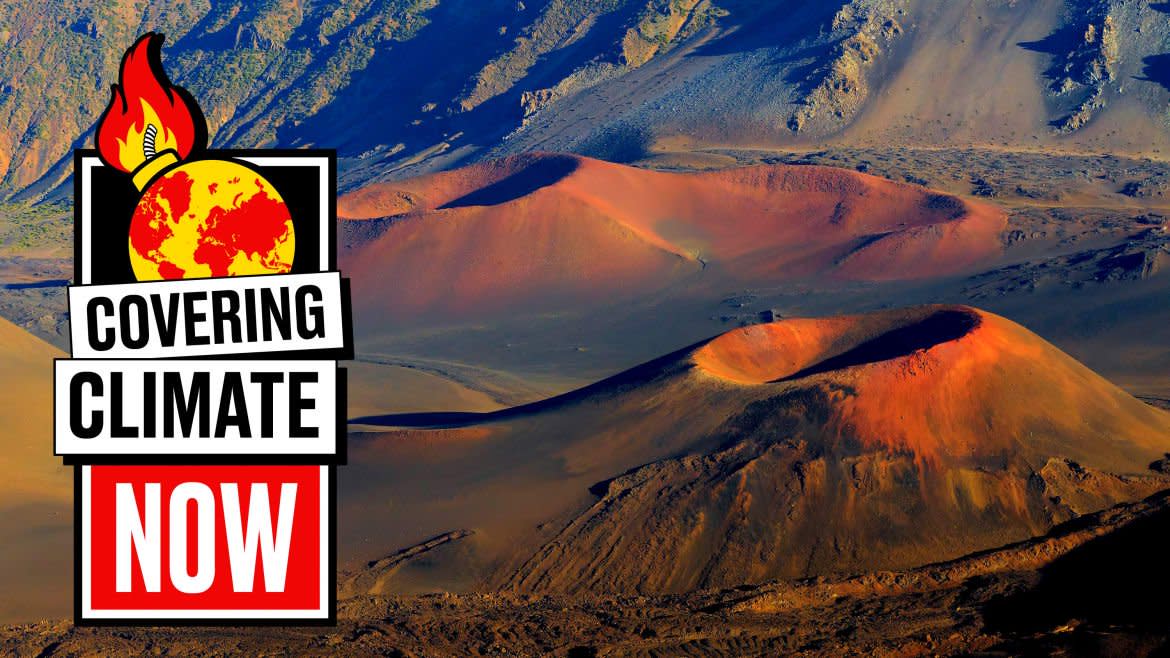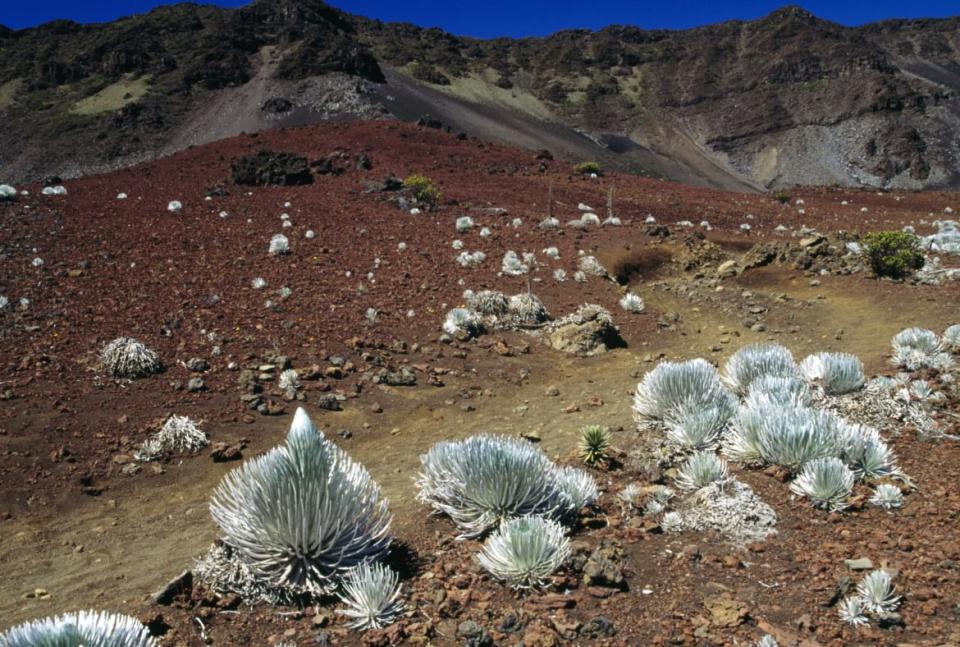Climate Change Could Turn Our National Parks Into Natural Disasters

This story is part of Covering Climate Now, a global collaboration of more than 220 news outlets to strengthen coverage of the climate story.
At 10,000 feet above Maui, near the dormant Haleakala caldera, is a 90-year old plant. This silver sphere of leaves shaped like swords (aptly named silversword) has waited nearly a century for this one epic moment—sending up a nearly six foot, bright green stalk covered in 600 purple flowers.
With this splendid crown resting on its aging head and its seeds scattered to the wind, it dies.
That it made it this far is becoming rare for its kind, though being in Hawaii’s protected Haleakala National Park has helped it survive. With climate change now a global emergency, the national parks we love—along with their defining colors, animal life, and landscapes—are facing an irrevocable loss, becoming unintentional pentimentos bearing the evidence of our poor foresight and apathy.

Silversword bushes (Argyroxiphium sandwicense) in Haleakala National Park, Maui Island, Hawaii.
Hawaii, for example, is home to 1,400 species, approximately 90 percent of them endemic to the region, according to the Division of Forestry and Wildlife. As small as the state is, it is home to 44 percent of the country’s “endangered and threatened plant species.” National parks like Haleakala are there to help protect many of these species.
Early in the last century, climbers would scale Haleakala and rip the giant flower off the silversword to take it home and prove they made it to the top. While that type of direct vandalism is no longer permitted, other threats are proving less manageable. The plant’s future at Hawaii’s Haleakala National Park—like thousands of plants and animals in all national parks—depends largely on controlling climate change.
In many cases, the very features after which parks are named are vanishing as a result of climate change.
Glacier National Park is the namesake of the glaciers that are rapidly disappearing. Just a century ago, there were 150 glaciers in the park; today there are 25; and by 2030 the park could be free of active glaciers.
Glacial melt is an annual, irreplaceable water source for life at Glacier, whose benefits trickle down to the park, allowing insects to thrive and a productive huckleberry crop that feeds the threatened population of grizzlies. Drier climates not only lead to glacial drought, it also leads to higher temperatures and more wildfires, like those that plagued the park last year.
Similarly, Joshua trees at Joshua Tree National Park are facing their own uncertain future. As a species, Joshua trees have been around from the Pleistocene upwards of 2.5 million years ago, and are strong survivors. Joshua trees live an average of 150 years, though one in California is believed to be close to 1,000 years old.
They are, however, no match for prolonged human activity.
A study published in June from UC Riverside Center for Conservation Biology of Joshua trees at the park, concludes that if climate change continues as it is, the famous tree faces “an almost complete elimination of the species from the park by the end-of-century.”
Earlier in the year during the government shutdown, the park made the news as vandals took advantage of it being unguarded and chopped several trees down. But even without direct threats like that happening every day, warmer weather and its subsequent drier soil leads to fewer seeds from the tree germinating.
There are few places not affected strongly by warming temperatures.
Yellowstone National Park and the Great Yellowstone area, for example, are increasingly experiencing warmer winters. The warmer temps not only lead to drier summers and more wildfires, they enable the mountain pine beetle to attack a recognizable feature of the park, the whitebark pine trees, leaving less of their nuts for the wildlife sustained by them.
In Florida, Everglades National Park is the “largest subtropical wilderness in the United States,” protector of the mangroves, home to threatened species, and an important barrier against hurricanes. It too is seeing unprecedented change driven by human activity. (Building projects have meant the draining of its waters and altering the system that keeps the Everglades functioning.)
On a larger scale, as the planet warms sea levels have risen and have increasingly pushed the freshwater-saltwater barrier inland in the Everglades, destroying marshes and causing mangroves to decline and retreat.
Other parks are not only affected by warming weather, but also by a build-up of air pollution.
The Great Smoky Mountains National Park, for example, is one of the nearly 90 percent of national parks facing problems due to air pollution from the burning of coal in the region. Much of the blue haze in the mountains comes from natural sources, but air pollution has generated it’s own haze, increasing health risks and reducing visibility—with visibility, of course, being one of the leading reasons people visit the park.
Over several decades, the Clean Air Act has helped to improve air quality and significantly reduce pollution there, but the Trump administration has taken aim at its regulations to weaken them, arguing that they hurt businesses.
The window for shifting these changes in the planet’s climate is either closed or closing—depending on the disaster scenario of the future that turns out to be most accurate. Scientific predictions of the future are not heart-warming.
A study from last year, for example, shows that sea level rise and storm surges are threatening national parks as “approximately one-fourth of all National Park Service sites are situated on or near the coast.” Another report from the U.N. in May shows that 1 million species are threatened with extinction—with a large portion only just decades away.
Studies like these have pushed many countries to feel a sense of urgency in handling climate change. On Sept. 23, for example, the U.N. convenes its Climate Action Summit in New York.
We are, it seems, reaching a type of inflection point, where the ease with which hurricanes can rise to a Category 5 and leave islands in complete devastation is hard to ignore and where a younger generation of leaders, like 16-year old Greta Thunberg, are calling everyone, including adults, to step up. (Having sailed on an emissions-free yacht across the Atlantic Ocean to speak at the Action Summit, Thunberg is herself a force of nature.)
While many nations have set out to keep the ball rolling on fighting climate change, the U.S. continues its trek backward to the outmoded thinking that helped create this mess, favoring industry profits now over long-term thinking.
America is a wealthy country, as President Trump recently noted, adding, “I’m not going to lose that wealth, I’m not going to lose it on dreams, on windmills, which frankly aren’t working too well.”
It’s a conviction he’s backed by abandoning the Paris Agreement, weakening the Endangered Species Act and regulations on methane gas last month, and reducing the power of the Clean Air Act. A recent analysis from the New York Times of the administration shows over 80 environmental rules being rolled back.
And the president is partially correct.
America’s not going to lose that wealth on windmills, rather it will lose it on short-sighted and greedy decisions by its leadership. That will tear apart the very land we claim to cherish and one of our best assets.
As historian Walter Stegner once said, the national parks are America’s “best idea,” but as it stands now, we may one day be grieving them as America’s greatest loss.
Get our top stories in your inbox every day. Sign up now!
Daily Beast Membership: Beast Inside goes deeper on the stories that matter to you. Learn more.

